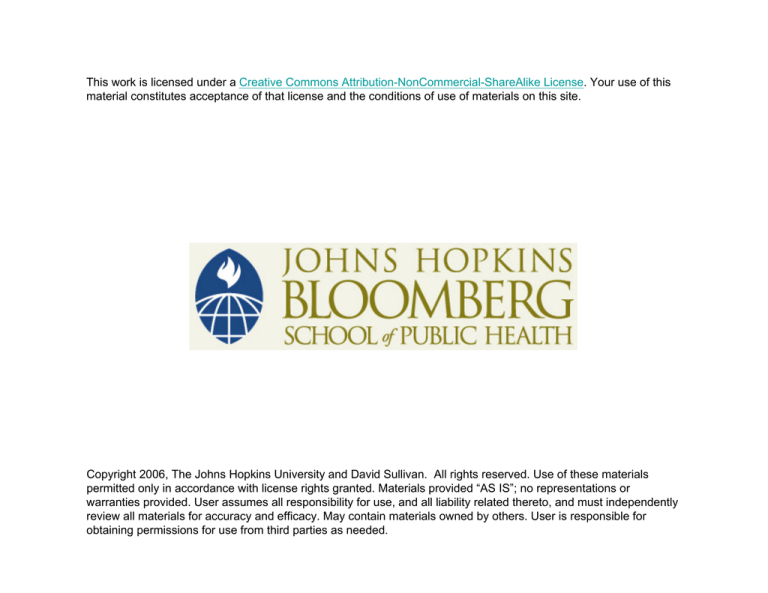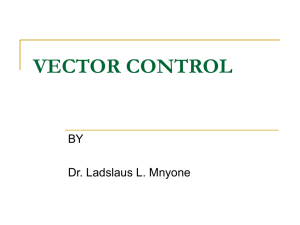
This work is licensed under a Creative Commons Attribution-NonCommercial-ShareAlike License. Your use of this
material constitutes acceptance of that license and the conditions of use of materials on this site.
Copyright 2006, The Johns Hopkins University and David Sullivan. All rights reserved. Use of these materials
permitted only in accordance with license rights granted. Materials provided “AS IS”; no representations or
warranties provided. User assumes all responsibility for use, and all liability related thereto, and must independently
review all materials for accuracy and efficacy. May contain materials owned by others. User is responsible for
obtaining permissions for use from third parties as needed.
Malariology
Overview
History, Lifecycle,
Epidemiology, Pathology,
and Control
David Sullivan, MD
Malaria History
•
•
•
•
•
•
•
2700 BCE: The Nei Ching (Chinese Canon of Medicine) discussed
malaria symptoms and the relationship between fevers and enlarged
spleens.
1550 BCE: The Ebers Papyrus mentions fevers, rigors,
splenomegaly, and oil from Balantines tree as mosquito repellent.
6th century BCE: Cuneiform tablets mention deadly malaria-like
fevers affecting Mesopotamia.
Hippocrates from studies in Egypt was first to make connection
between nearness of stagnant bodies of water and occurrence of
fevers in local population.
Romans also associated marshes with fever and pioneered efforts to
drain swamps.
Italian: “aria cattiva” = bad air; “mal aria” = bad air.
French: “paludisme” = rooted in swamp.
Cure Before Etiology: Mid 17th
Century - Three Theories
•
PC Garnham relates that following: An earthquake caused destruction in
Loxa in which many cinchona trees collapsed and fell into small lake or
pond and water became very bitter as to be almost undrinkable. Yet an
Indian so thirsty with a violent fever quenched his thirst with this
cinchona bark contaminated water and was better in a day or two.
•
Alternatively, Indians working in mountain mines drank cinchona tea to
stop shivering.
•
Subsequent story is administration of bark to Countess of Cinchon by
Jesuits
Malaria and Military
•
•
•
•
Revolutionary War: US Congress bought cinchona bark from
South America to treat soldiers with malaria.
Civil War: 1,200,000 cases 8,000 deaths.
WWI: Almost 5,000 cases with 7 deaths in US Navy and
Marines; more than 100,000 cases in British and French
soldiers.
WWII: 500,000 cases in US Army; more than 110,000 cases
with 90 deaths in US Navy and Marines.
"This will be a long war, if for every division I have
facing the enemy, I must count on a second
division in the hospital with malaria, and a third
division convalescing from this debilitating
disease.“ - General Douglas MacArthur
Malaria: The Trail of Pigment
•1847: Meckel identified pigment in blood of insane person.
•1848: Virchow pictured and described pigmented bodies in blood of
malarial patient
•1850: Hischl connected presence of pigment and intermittent fever
•1880: Laveran identified pigment in body of living parasite in 26
patients. He is credited with describing the etiologic agent of malaria.
•In the 1890's British scientist Patrick Manson theorized that
mosquitoes may be involved in malaria transmission. Manson had
recently found that mosquitoes could vector filarial worms that caused
elephantiasis.
•Two Johns Hopkins medical students Opie and MacCallum who were
the first to describe sexual reproduction of Plasmodium in birds and
man.
•Manson to Ross, 3/22/1898: “Don’t forget MacCallum’s discovery of
the flagellum impregnation of halteridium spheres … I think I mentioned
to you what I thought was the explanation, if MacCallum is right, of the
mosquito pigmented cell.
Ronald Ross comments on cells outside
the stomach of the Anopheles mosquito:
"but what now arrested attention was the
fact that each of these bodies contained
a few granules of black pigment
absolutely identical in appearance with
the well-known and characteristic
pigment of the parasite of malaria (large
quartans and crescent-derived spheres)."
Ross, Ronald British Medical Journal
1:1786-1788 (1897)
Manson to Ross, 4/29/1898
Source: CDC
“It is a delight to watch how the thing is panning out.
What a frightful shock it would have been to us had
the Yanks done this.”
1948: Shortt and Garnham Describe Exoerythrocytic Stages
of Human Malaria Parasites
Malarial sporozoites in mosquito salivary
gland smear.
Source: BIODIDAC/J. Houseman
Histopathology of malaria exoerythrocytic
forms in liver.
Source: CDC
Definitive host
mosquito
Oocysts on gut wal
28 days
In mosquito
Ingests 3 ul of blood
With 100-300 gametes
100’s
Sporozoites
trophozoite
schizont
Within hours
invades 1-2
liver cells
Gametocytes
Viable for 28 days
Plasmodium
Life Cycle
48-72 hrs
ring
Clinical signs and symptoms in erythrocytic stages of ring,trophozoite and schizont
1,000’s
released
Merozoites in liver for
seven to 10 days. P. vivax
& ovale hypnozoite for
Months.
Malaria Species
P. falciparum
P. vivax
P. ovale
P. malariae
5-6
8
9
15
2
2
2
3
Hypnozoites (relapses)
No
Yes
Yes
No
Merozoites per schizont
30,000
10,000
15,000
2,000
All; prefers younger cells
Retics
Retics
Older RBCs
Hepatic Development
Phase
Erythrocytic Cycle (days)
RBC preference
Plasmodium falciparum: High percent rings
Source: Thomas Spahr and David Sullivan JHMRI
Plasmodium malariae: Band forms
Source: CDC/ Steven Glenn, Lab & Consultation Division
Plasmodium vivax: Enlarged erythrocytes
Source: CDC/Dr. Mae Melvin
Plasmodium ovale: Oval or comet shape
Source: CDC/Dr. Mae Melvin
Classical Malaria:
Hippocrates 5th Century BCE
• Fever
• Splenomegaly
• Anemia
Clinical Complications of Malaria
P. falciparum
1. Cerebral coma
2. Anemia
3. Pulmonary edema
4. Renal Failure
5. Shock
6. Lactic acidosis
7. Hypoglycemia
8. Tropical splenomegaly
9. Pregnancy
a. Maternal death
b. Stillbirth
c. Low birth weight
d. Anemia
P. vivax (P. ovale)
1. Splenic rupture
2. Anemia (mild)
3. Debilitating fevers
4. Higher TNF-α per parasite
P. malariae
1. Immune complex
2. Glomerulonephritis, leading
to nephrotic syndrome
Edema
brought on
by nephrosis
associated
with malaria.
Source: CDC/Dr. Myron Schultz
Why do we
see
predominately
rings only in
peripheral
circulation
with P.
falciparum?
Images from CDC
Placental Malaria
Unstable epidemiology
Maternal death, abortion, stillbirth, premature delivery, low
birthweight
Stable (Holoendemic) epidemiology
Clinical symptoms and parasitemia is higher in primigravida
Low birthweight
Non-immunes
Higher mortality
Progressive anemia
Quinine induced hypoglycemia
The Numbers
•
70 kg person X @70 ml / kg = 4.9 liters of blood @ 5 liters =
5X103 ml = 5X106 µl
•
5X106 RBCs per µl of blood
•
2.5 X 1013 RBCs
•
1% parasitemia (50,000 ul)= 1 in 100 iRBCs = 2.5 X 1011
parasites per person
•
A million people each day have this symptomatic burden = 2.5x
1017+1 total parasites in world
Recrudesence & Relapse
Recrudescence
Renewed manifestation of infection due to survival of
erythrocytic forms
Relapse
Renewed manifestation of infection arising from
survival of exoerythrocytic forms (hypnozoites)
P. vivax or P. ovale only
100%
P. vivax %
P. falciparum %
P. malariae %
P. ovale %
Total %
Percentage of all cases
80%
60%
40%
20%
0%
0-29
30-89
90-179
180-364
>365
Days to Onset of Illness for all US cases in 4 yrs
Interval
(days)
0-29
30-89
90-179
180-364
>365
Total
P. vivax
P. falciparum
P. malariae
P.ovale
Total
750
562
554
605
127
2598
1,542
157
35
21
7
1762
103
35
37
28
6
209
27
28
34
33
11
133
2422
782
660
687
151
4702
•
100 countries in malaria endemic areas.
•
half in sub-Saharan Africa.
•
2.4 billion at risk.
•
300 to 500 million cases each year.
•
1.0 to 2.7 million deaths in children.
•
Malaria constitutes 25% of child mortality in Africa.
•
90% of all malaria mortality is in under children under 5.
•
Low birth weight, preterm delivery, cerebral malaria, and severe
malarial anemia are major causes of mortality.
•
Sequelae from severe clinical complications include cognitive
impairment, behavioral disturbances, spasticity, and epilepsy as
well as vision, hearing, and speech impairments.
Parasite Control
1. Vector control & Sanitation
2. Vaccines?
3. Chemotherapy
Protective (prophylaxis)
Curative
Prevention of transmission
oocysts
Sporozoites
Antifolates-proguanil,
pyrimethamine
Gametocytes
Primaquine
(hypnozoites of
P.vivax&ovale)
trophozoite
Artemisinin
Quinolines- chloroquine,
mefloquine, quinine
Antibacterials-tetracycline,clindamycin,
fluoroquinolone(Cipro)
}
Sporozoites
merozoites
schizont
48-72 hrs
ring
Atovoquone
INNATE RESISTANCE TO MALARIA
Red Cell Polymorphism and Malaria: Polymorphic alternative versions of the
same gene coexist in a population at frequencies well above that explained
by repeated occurrence of the mutation that produces the variant.
The Malaria Hypothesis
Geographical distribution of red cell polymorphisms due to selective effect of
malaria on heterozygote.
Conditions with reasonable evidence to support the malaria hypothesis are:
Sickle cell trait and disease, thalassemia's, glucose-6-phosphate
dehydrogenase deficiency and, Duffy blood group and hereditary
ovalocytosis.
Hemoglobin Variants
Hemoglobin S: valine for glutamic acid at AA 6 in beta chain
Hemoglobin C: lysine for glutamic acid at AA 6 in beta chain
Hemoglobin E: lysine for glutamic acid at AA 26 in beta chain
"Stimulate the Phagocytes. Drugs are a Delusion.”
GB Shaw, The Doctor's Dilemma 1906
"I myself have been infected with malaria only once in
spite of nineteen years' of service in India and thirteen
subsequent 'malaria expeditions' to warm climates;
and I attribute this to my scrupulous use of the bed
net.“
Ronald Ross Studies on Malaria 1928.
"We must learn to shoot microbes with magic bullets.“
Paul Ehrlich in Microbe Hunters Paul de Kruif 1926
Summary
•
•
•
•
•
•
•
•
How often the mosquito bites influences disease severity.
Fever corresponds with rupture from erythrocyte.
In lethal P. falciparum rings predominate in circulation because
older forms are adhering to tissue capillary beds to cause
hypoxia and end organ damage.
P. falciparum malaria is a medical emergency in the nonimmune
patient.
Human genetic polymorphisms such as sickle cell disease,
thalassemia’s, glucose 6 phosphate deficiency, and lack of
Duffy factor protect from severe disease but not infection.
P. vivax and ovale can relapse from liver after effective
erythrocyte treatment. Primaquine specifically treats this liver
stage.
P. falciparum resistance refers to recrudescence where red
blood cell parasites decrease in number before rising again.
Most current antimalarials do not effect gametocytes, which
translates to infectivity to the mosquito
Johns Hopkins University Malaria Firsts
•
•
•
•
Under Osler’s direction, Johns Hopkins Hospital was the first in
the world to perform routine malaria blood film analysis on all
febrile patients in 1889.
Two medical students, Opie and MacCallum, were the first to
describe sexual reproduction of Plasmodium in birds and
humans.
In 1897, Welch actually coined the species name of falciparum
in contrast to the proposed “falciforme” for the lethal AestivoAutumnal fever.
The WWII wartime Survey of Antimalarial Drugs centered at
Johns Hopkins solidly identified SN-7618 (SN = Survey
Number) or chloroquine as the drug of choice for malaria. Dr.
EK Marshall at Johns Hopkins actually coined the name
chloroquine in Nov 1945.
Resources
•
•
•
•
•
•
CDC Malaria Hotline Number
– 404-332-4555 (24 hrs a day)
CDC guidelines for malaria
– http://www.cdc.gov/travel/malinfo.htm
CDC guidelines for travel with outbreak information
– http://www.cdc.gov/travel/travel.html
Online blood film knowledge testing
– http://www.rph.wa.gov.au/labs/haem/malaria/index.html
(This web site is presented by the Division of Laboratory
Medicine at Royal Perth Hospital)
Nick White. The Treatment of Malaria. N Engl J Med
1996;335:800-806
Djimde et al. A Molecular Marker for Chloroquine-Resistant
Falciparum Malaria. N Engl J Med 2001;344:257-63




